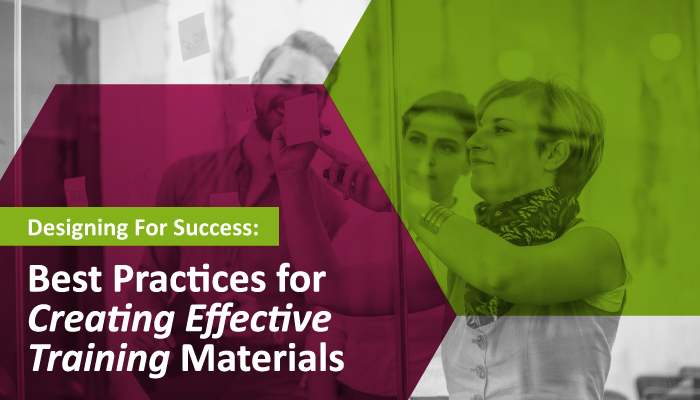
Designing for Success: Best Practices for Creating Effective Training Materials
Designing effective training materials is essential for supporting knowledge transfer and performance development, but where does one start?
First, be confident that training is the right solution by evaluating needs, instructional strategies, technology requirements, metrics for success, and more. Next, follow a specific instructional design process model like ADDIE to create practical, iterative materials collaboratively.
Then, select the appropriate delivery method, whether instructor-led training, virtual instructor-led training, or blended learning solutions, that aligns with your instructional strategies—additionally, tailor materials to your learners’ needs and backgrounds. Finally, measure effectiveness using Kirkpatrick’s four levels of evaluation. By following these best practices in crafting training materials, you can ensure an engaging, effective program capable of achieving the desired learning outcomes.
Best Practice #1: Be Confident Training Is the Solution
Designing an effective training program begins by recognizing a performance problem and then determining whether training can provide a solution. To help determine whether training is the solution, consider the following:
- Do the learners have the skills required to accomplish the learning?
- What instructional strategies would work best for learners and the concepts or skills?
- What technology is required?
- What type of support is required?
- How will success be measured?
- How will revisions be handled when updates are necessary?
Best Practice #2: Follow a Specific Design Process/Model
An instructional design process model is the methodology used to create learning or training. The Model you use should be iterative, collaborative, efficient, and practical. There are many models to choose from. To learn more, Northwestern University provides details about five key models, including Addie, Backward Design, Design Thinking Model, Fink’s Significant Learning Model, and ARCS Model.
Best Practice #3: Select the Appropriate Delivery Method
From extended reality training to the traditional instructor-led classroom, the delivery method you choose will drive your instructional strategies and materials. However, the materials must be clear and well-organized regardless of the methodology.
This means that the materials should be structured in a logical and easy-to-follow manner. Additionally, the materials should be visually appealing, with high-quality images, charts, and diagrams used to illustrate key concepts, make the material more engaging, and include application.
Best Practice #4: Tailor Materials to the Needs of the Learners
It starts with knowing your audience. Your content will vary depending on the learner’s level of knowledge and skill, their learning style preferences, and even their generational cohort. In addition, the materials should be culturally and linguistically appropriate for the learners and should consider any special needs or accommodations that may be required.
Best Practice #5: Measure the Effectiveness of the Training
You create a training program to meet a specific goal or objective. How will you know your objective is met?
For six decades, trainers have used the Kirkpatrick Model to develop training needs assessments. The Model has four distinct levels: reaction, learning, behavior, and results. Whether you do a post-training evaluation, observe learners doing tasks on the job, or analyze factors like improved employee engagement, the review is necessary to identify strengths and weaknesses that will result in improvements.
Conclusion
In conclusion, effective training materials are critical to the success of any training program. To create such materials, one must follow best practices that include being confident that training is the solution, following a specific design process or model, selecting the appropriate delivery method, tailoring the materials to the needs of the learners, and measuring the effectiveness of the training. By following these practices, you can ensure that your training program will be engaging, effective, and capable of meeting the learners’ needs. So, let’s get started, and create training materials that deliver results!